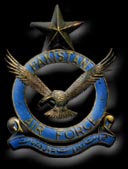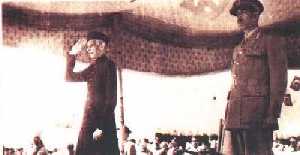|
|
|
PAKISTAN AIR FORCE Second to none
|
PAKISTAN AIR FORCE 1965
|
|||
 |
Defenders Of Pakistan Courage is their weapon - Allah is their guide The sub-continent has already seen 3 very bloody wars, but if another one breaks out, it will be the most deadly conflict by far. Pakistan posesses nuclear weapons, or the capability to produce them within a matter of hours, and so do other countries in the region. Total annihilation of warring countries has become a very possible scenario. Over the past many years, the Pakistan armed forces have concentrated on setting specific strategic goals, and then committing their resources to achieve them. This has resulted in a very level-headed approach to acquiring new weaponry, a department in which Pakistan has gained much expertise. The focus is not so much on hyped-up weapon systems, but rather on equipment that will give Pakistan an edge in a future conflict. If it comes to an all out war, Pakistan today has the delivery systems to strike anywhere in a plausible future theatre of conflict, possibly with nuclear weapons. An analysis of Pakistan's strategic weaponry follows, alongwith discussion of the probable scenario preceding its use. One of Pakistan's most potent weapons, the F-16 Fighting Falcon, with a maximum range of over 2,200 km, will in any future war, most likeley be used to penetrate deep inside enemy territory. However, to assure an F-16 strike force' safest possible passage, it is very likely that any strategic bombing missions would be preceded by a missile strike aiming to neutralise enemy forward air defences - this is a very practical option given that both Hatf I (Range 60km) and Hatf II (Range 350km, nuclear capable) have been in production since the last many years and can be liberally used to achieve this aim - given the low time to target and quick deployment because of the Hatf's solid rocket motors, not much time would have to be wasted in waiting for the path to be cleared. It is probable that the F-16 strike fighters would be accompanied by the agile F7P, of which the PAF currently has 160. This dogfighter has been heavily refitted by the PAF and now incorporate state of the art avionics and weapon systems, including Sidewinder AAMs. For all targets within 800km of the Pakistani border, it is most likely that Pakistan will opt to use the indeginously developed Hatf III SSM. This missile has a current range of 800km and can carry nuclear warheads, delivering them with impressive accuracy. Hatf III, like it's earlier counterparts, can be launched from mobile launch platforms, making it's detection and destruction before launch, very difficult. Ghauri, a missile project that is still in development, is quoted by CDISS as being a nuclear capable missile with a range of 1,500km -- almost twice the range of Hatf III. It has been reported by several defense analysts [see the book 'Fazayya'], that Pakistan in a state of war would have 'access' to an E3C electronic recce. aircraft. Strategists think that this would be 'lent' by the Saudis. Such co-operation has occured in the past and hence cannot be ruled out. In such an event, not only would the PAF have prior warning much before any aircraft or missiles enter Pakistani air-space, it would also be able to better plan routes of access to targets in enemy airspace, warning its attack squadrons of the presence of CAPs in the area. In 1965 when Pakistani warships successfully destroyed the electronic countermeasures and detection center in Dwarka, the surface srike role of the Pakistan Navy was proved as a useful tool in the hands of the nation's defence planners. Today, the Agosta submarines of the Pakistan Navy, which are essentially identical to the French nuclear subs except that they use diesel engines. They are much more silent than submarines held by other Navies in the region and are equipped with surface strike missiles. These boats have the capability to wander, undetected, into enemy waters and launch strikes against coastal towns. The Agosta class submarines carry Harpoon cruise missiles which have a range of 120km and though are essentially Anti-ship missiles, but can be used in a surface strike role also. Pakistan, has been investing heavily in anti-missile defenses which are also very effective against enemy aircraft. Such defenses include Phalanx CIS - an independently functioning 'gattling' style gun that comes with it's own radar and targetting equipment and essentially creates a cloud of HE shells in the area where a missile is detected to be approaching from. Apart from this, Pakistan also has both permenantly deployed and mobile, Oerlikon gun and cannon systems which are supposed to be extremely effective against missiles. |
|||
|
News |
||||
|
Pakistan Air force |
 |
|||